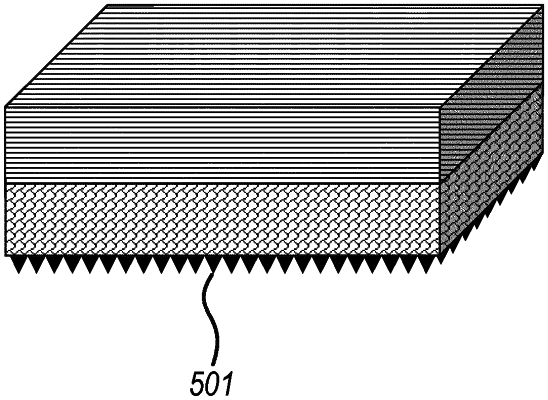| CPC A61L 27/507 (2013.01) [A61F 2/0095 (2013.01); A61F 2/06 (2013.01); A61L 27/18 (2013.01); A61L 27/26 (2013.01); A61L 27/34 (2013.01); A61L 27/3633 (2013.01); A61L 27/54 (2013.01); A61L 27/58 (2013.01); A61F 2220/0016 (2013.01); A61L 2300/418 (2013.01); A61L 2420/02 (2013.01)] | 29 Claims |

|
1. A vascular repair patch comprising a polymeric substrate having first and second major surfaces, wherein the substrate comprises at least:
(i) a first polymer filament layer adjacent the first major surface comprising a plurality of polymer filaments wherein the polymer filaments are oriented in parallel; and
(ii) a second polymer filament layer adjacent the second major surface comprising a plurality of polymer filaments wherein the polymer filaments are oriented randomly;
wherein:
the polymer filaments of the first and second polymer filament layers comprise at least 50 wt % polycaprolactone (PCL) and up to 50 wt % poly(lactic-co-glycolic acid) (PLGA), wherein the PLGA has a lactide:glycolide ratio of 80:20 to 20:80;
the polymer filaments of the first and second polymer filament layers have an average filament diameter in a range of from 1 to 20 μm, and diameters of the polymer filaments of at least one of the first and second polymer filament layers form a bimodal distribution with one peak in a range of from 0.2 to 2 μm and a second peak in a range of from 2.5 to 10 μm;
the polymeric substrate has a Young's modulus in a range of from 0.5 to 3.0 MPa;
the polymer filaments of the first polymer filament layer are oriented with a standard deviation of no more than 18°, and the polymer filaments of the second polymer filament layer are oriented with a standard deviation of at least 63°;
the second polymer filament layer has an average porosity of from 40 to 60%;
the vascular repair patch has a total thickness in a range of from 50 μm to 500 μm, and the second polymer filament layers independently has a thickness in a range of from 20 μm to 200 μm;
the first polymer filament layer of the vascular repair patch comprises one or more extracellular matrix compounds in an areal amount of from 1 μg/cm2 to 50 μg/cm2, based on a surface area of the first major surface of the vascular repair patch, and wherein the one or more extracellular matrix compounds are selected from collagen (particularly collagen types I and II), elastin, fibronectin, laminins, VE-cadherin, vitronectin, integrins, heparan sulfate, chondroitin sulfate, ketaran sulfate, hyaluronic acid, and peptide sequences selected from example Arg-Gly-Asp (RGD), Arg-Glu-Asp-Val (REDV), Tyr-Ile-Gly-Ser-Arg (YIGSR);
the second polymer filament layer comprises one or more thrombogenic agents selected from tissue factor (TF, or Factor III), Factor VII, Factor X and Fibrin; and
the second polymer filament layer comprises the one or more thrombogenic agents in an areal amount of from 0.5 μg/cm2 to 100 μg/cm2, based on a surface area of the second major surface of the vascular repair patch.
|